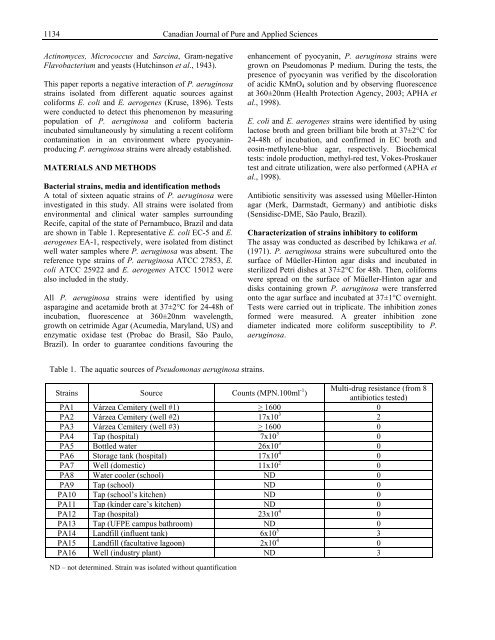Download (5Mb) - Covenant University Repository
Download (5Mb) - Covenant University Repository
Download (5Mb) - Covenant University Repository
You also want an ePaper? Increase the reach of your titles
YUMPU automatically turns print PDFs into web optimized ePapers that Google loves.
1134<br />
Actinomyces, Micrococcus and Sarcina, Gram-negative<br />
Flavobacterium and yeasts (Hutchinson et al., 1943).<br />
This paper reports a negative interaction of P. aeruginosa<br />
strains isolated from different aquatic sources against<br />
coliforms E. coli and E. aerogenes (Kruse, 1896). Tests<br />
were conducted to detect this phenomenon by measuring<br />
population of P. aeruginosa and coliform bacteria<br />
incubated simultaneously by simulating a recent coliform<br />
contamination in an environment where pyocyaninproducing<br />
P. aeruginosa strains were already established.<br />
MATERIALS AND METHODS<br />
Bacterial strains, media and identification methods<br />
A total of sixteen aquatic strains of P. aeruginosa were<br />
investigated in this study. All strains were isolated from<br />
environmental and clinical water samples surrounding<br />
Recife, capital of the state of Pernambuco, Brazil and data<br />
are shown in Table 1. Representative E. coli EC-5 and E.<br />
aerogenes EA-1, respectively, were isolated from distinct<br />
well water samples where P. aeruginosa was absent. The<br />
reference type strains of P. aeruginosa ATCC 27853, E.<br />
coli ATCC 25922 and E. aerogenes ATCC 15012 were<br />
also included in the study.<br />
All P. aeruginosa strains were identified by using<br />
asparagine and acetamide broth at 37±2°C for 24-48h of<br />
incubation, fluorescence at 360±20nm wavelength,<br />
growth on cetrimide Agar (Acumedia, Maryland, US) and<br />
enzymatic oxidase test (Probac do Brasil, São Paulo,<br />
Brazil). In order to guarantee conditions favouring the<br />
Canadian Journal of Pure and Applied Sciences<br />
Table 1. The aquatic sources of Pseudomonas aeruginosa strains.<br />
enhancement of pyocyanin, P. aeruginosa strains were<br />
grown on Pseudomonas P medium. During the tests, the<br />
presence of pyocyanin was verified by the discoloration<br />
of acidic KMnO4 solution and by observing fluorescence<br />
at 360±20nm (Health Protection Agency, 2003; APHA et<br />
al., 1998).<br />
E. coli and E. aerogenes strains were identified by using<br />
lactose broth and green brilliant bile broth at 37±2°C for<br />
24-48h of incubation, and confirmed in EC broth and<br />
eosin-methylene-blue agar, respectively. Biochemical<br />
tests: indole production, methyl-red test, Vokes-Proskauer<br />
test and citrate utilization, were also performed (APHA et<br />
al., 1998).<br />
Antibiotic sensitivity was assessed using Müeller-Hinton<br />
agar (Merk, Darmstadt, Germany) and antibiotic disks<br />
(Sensidisc-DME, São Paulo, Brazil).<br />
Characterization of strains inhibitory to coliform<br />
The assay was conducted as described by Ichikawa et al.<br />
(1971). P. aeruginosa strains were subcultured onto the<br />
surface of Müeller-Hinton agar disks and incubated in<br />
sterilized Petri dishes at 37±2°C for 48h. Then, coliforms<br />
were spread on the surface of Müeller-Hinton agar and<br />
disks containing grown P. aeruginosa were transferred<br />
onto the agar surface and incubated at 37±1°C overnight.<br />
Tests were carried out in triplicate. The inhibition zones<br />
formed were measured. A greater inhibition zone<br />
diameter indicated more coliform susceptibility to P.<br />
aeruginosa.<br />
Strains Source Counts (MPN.100ml -1 )<br />
Multi-drug resistance (from 8<br />
antibiotics tested)<br />
PA1 Várzea Cemitery (well #1) > 1600 0<br />
PA2 Várzea Cemitery (well #2) 17x10 3<br />
2<br />
PA3 Várzea Cemitery (well #3) > 1600 0<br />
PA4 Tap (hospital) 7x10 3<br />
0<br />
PA5 Bottled water 26x10 3<br />
0<br />
PA6 Storage tank (hospital) 17x10 4<br />
0<br />
PA7 Well (domestic) 11x10 2<br />
PA8 Water cooler (school) ND 0<br />
PA9 Tap (school) ND 0<br />
PA10 Tap (school’s kitchen) ND 0<br />
PA11 Tap (kinder care’s kitchen) ND 0<br />
PA12 Tap (hospital) 23x10 4 0<br />
PA13 Tap (UFPE campus bathroom) ND 0<br />
PA14 Landfill (influent tank) 6x10 5<br />
PA15 Landfill (facultative lagoon) 2x10 4 0<br />
PA16 Well (industry plant) ND 3<br />
ND – not determined. Strain was isolated without quantification<br />
0<br />
3

















